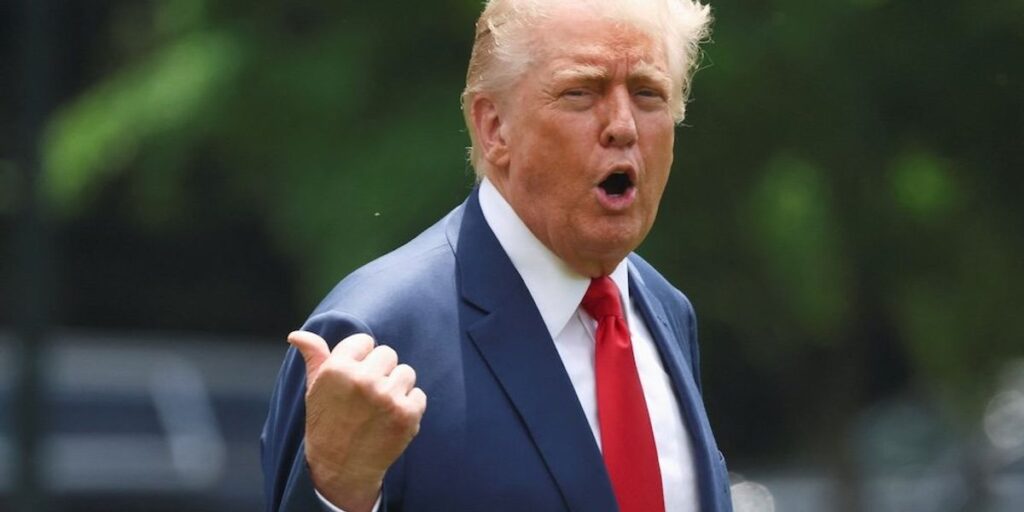
The world watched as President Donald Trump attempted to broker peace between Israel and Iran, only to find himself caught in a storm of his own making. On Monday night, Trump announced a ceasefire between the two nations, hoping to present himself as a diplomatic hero at the upcoming NATO summit. However, the situation quickly unraveled as hostilities resumed, leaving Trump to navigate the fallout of a conflict that was as much about television optics as it was about international diplomacy.
Trump’s televised use of profanity to describe the situation was seen by many in the Washington press corps as a paternal rebuke, likening the scenario to a father scolding unruly children. Yet, instead of projecting strength, the president appeared vulnerable and out of control. His attempt to claim victory over Iran’s nuclear ambitions was undermined by reports from multiple sources, including the Pentagon, which suggested that Iran’s nuclear capabilities remained largely intact.
The Ceasefire That Wasn’t
Late Monday, Trump declared that he had successfully negotiated a ceasefire between Israel and Iran. This announcement was intended to bolster his image as a peacemaker ahead of the NATO summit. However, the fragile peace quickly disintegrated when Israel launched further attacks on Iran, prompting retaliatory strikes. Trump’s frustration was palpable as he lamented, “We basically have two countries that have been fighting so long and so hard that they don’t know what the fuck they’re doing.”
Reports from The Washington Post and The New York Times revealed that Israeli Prime Minister Benjamin Netanyahu had been planning an attack on Iran for over a year. Trump’s involvement seemed more about seeking the spotlight than strategic calculation, as he reportedly admired the spectacle of Israel’s military actions on live television.
Strategic Missteps and Political Fallout
According to an internal Pentagon assessment reported by major news outlets, Iran’s nuclear program was only temporarily set back, not destroyed as Trump claimed. The assessment suggested that Iran had moved its enriched uranium to safer locations, out of reach of American bunker-busting bombs. Despite the billions spent on military operations, the outcome was far from the “complete and total obliteration” Trump had boasted about.
“The result of all the bunker-busting bombs, and the billions spent dropping them, is a far cry from Trump’s claim over the weekend of having ‘completely and totally obliterated’ Iran’s nuclear program.”
At a NATO press conference, Trump doubled down on his claims, dismissing the Pentagon’s assessment and attacking the media as “scum.” His administration, including Secretary of Defense Pete Hegseth and Secretary of State Marco Rubio, was enlisted to support his narrative, despite the growing evidence to the contrary.
Implications for U.S. Foreign Policy
The repercussions of this diplomatic debacle are significant. Hegseth announced that the FBI would investigate leaks regarding the Pentagon’s assessment, signaling a crackdown on information sharing. The administration’s decision to limit classified information to Congress further underscores the tension between the executive branch and legislative oversight.
Meanwhile, Netanyahu’s strategic maneuvering has left Iran more united internally and potentially more determined to advance its nuclear program. As Trump prepares for renewed talks with Iran, the stage is set for further diplomatic challenges. Experts suggest that Iran may agree to negotiations while continuing its nuclear activities, testing Trump’s ability to effectively manage international relations.
Historical Parallels and Expert Insights
Professor William Adler of Northeastern Illinois University draws parallels between Trump’s situation and past U.S. presidents who faced similar dilemmas. He notes that leaders like James Madison and William McKinley were also pressured into conflicts by external forces, highlighting the complexities of presidential decision-making in the face of aggressive foreign policies.
“Some presidents of the past have gotten themselves in situations where moving forward was the easiest solution when pulling back seemed too difficult politically.”
Adler’s analysis suggests that Trump’s desire for a “made-for-TV” resolution is reminiscent of past leaders who sought quick, decisive victories but were ultimately constrained by geopolitical realities. The situation underscores the challenges of balancing domestic political pressures with the demands of international diplomacy.
As the world watches, the potential for further conflict remains. While Trump may claim victory, the long-term implications of his actions are uncertain. The president’s approach to foreign policy, characterized by a focus on media optics and personal bravado, will continue to shape U.S. relations with the Middle East and beyond.
In the coming weeks, the international community will be closely monitoring the outcome of Trump’s negotiations with Iran, as well as the broader implications for regional stability. The president’s ability to navigate these complex issues will be a critical test of his leadership on the world stage.







